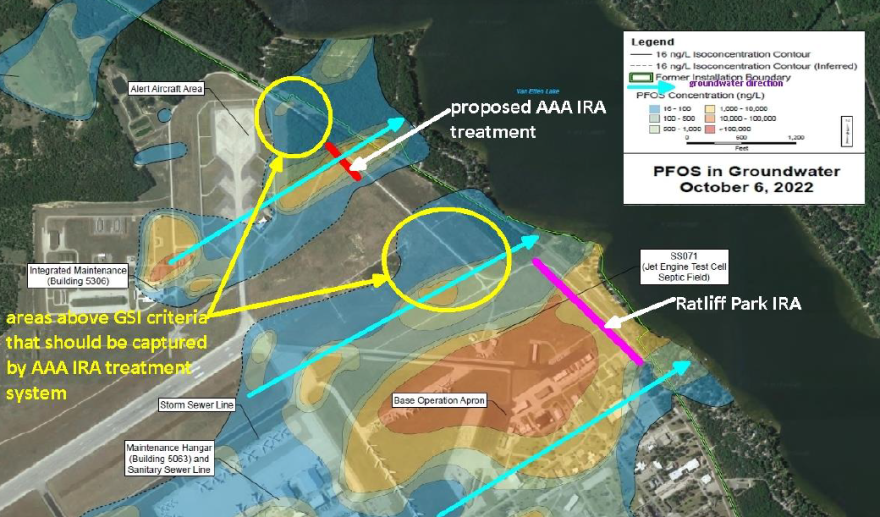Oscoda residents are calling on the U.S. Air Force (USAF) to scale up a proposed PFAS treatment system on the former Wurtsmith Air Force Base.
Last month, the USAF presented three options for a system that would treat approximately 288,000 gallons of contaminated groundwater a day on the base's Alert Aircraft Area.
The goal is to limit PFAS from further leaching into Van Etten Lake, but the USAF's preferred system only targets the "highest concentrations" of contaminants. Community members say it ignores nearby hotspots with PFAS levels that exceed state standards.
"We're delighted that you're going to do this interim remedial action (IRA) — now do the IRA, so that it takes care of all threats, not just the 'worst' threats, to human health and the environment," said Kyle Jones, a member on the Wurtsmith Restoration Advisory Board (RAB).
Jones said he believes the USAF's preferred system fails to meet the conditions of a federal cleanup law.
"They've already decided that it is enough of a dire or acute threat, and so to then say, 'we're only going to do a partial remedy' — in my view, violates CERCLA," said Jones, a retired environmental lawyer. "... Even a layperson could say it just doesn't make sense."
In a document outlining the plan, the USAF states the preferred option is in compliance with CERCLA, and "a final remedy will be selected to address all PFAS that exceed standards" once a feasibility study for the site is complete.
"This preferred alternative provides the best balance of [CERCLA] criteria, such as protection of human health and the environment, long-term effectiveness and permanence, short-term effectiveness, and cost," the USAF plan states.
The USAF's preferred system involves installing five new extraction wells along Perimeter Road near Swise Road, that would pump water to a nearby facility. Water would be treated by three granulated activated carbon (GAC) units, and discharged in an infiltration gallery above the water table, north of the extraction wells.
This plan is slated to cost approximately $23.6 million over a 30-year operating period.
Jones said expanding the system from the get-go is a "drop in the bucket," when considering the USAF's responsibility to the community and the long-term costs of cleanup.
RAB co-chair Mark Henry estimates the system would need 15 additional extraction wells and increased capacity to address nearby plumes by the Van Etten Lake State Forest Campground and Ken Ratliff Memorial Park.
"We generally feel that the proposed IRA is insufficient for the need at hand and request that the scope of the IRA be modified to be a much more robust system," Henry wrote in a letter to the USAF submitted during public comment on the proposed plan.
In an email to WCMU, Mark Kinkade, with the Air Force Installation and Mission Support Center Public Affairs, said the plan is subject to change.
"We recently received data from our remedial investigation...that may result in some changes to the plan," Kinkade said. "After discussion with EGLE, we will continue the IRA as designed while we evaluate the data. We will continue to adjust the IRA as needed to ensure it is most effective in address(ing) PFAS impacts."
Kinkade said adding extraction wells is still a possibility, but in the meantime, the USAF is moving forward with the preferred plan.

During the public comment period on the plan, several community RAB members referenced a national directive from the Department of Defense, that mandates "interim remedial actions" (IRAs) to be implemented across contaminated military installations.
An IRA is meant to address immediate environmental and health concerns (while fitting into a long-term cleanup plan), but residents say the plan falls short of its promises in protecting the community from contamination.
"CERCLA and the DoD directive mandate [the inclusion of the state campground and township park plumes], and the Air Force cannot arbitrarily exclude those plumes..." Tony Spaniola wrote on behalf of the Great Lakes PFAS Action Network."
Spaniola, along with other commenters, requested the USAF get input on the plan from the new Critical Process Analysis (CPA) team, which was appointed to design and implement other interim actions.
Public comment on the plan ended last month. Construction of the system is expected to begin in April.
Editor's note: This story was updated Nov. 9 after WCMU received more information from the USAF about how the plan is subject to change.





